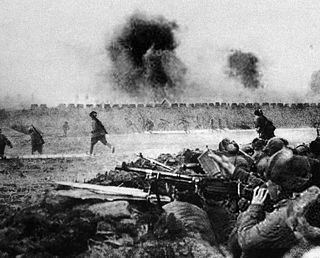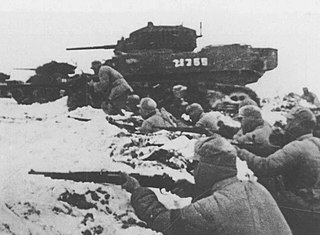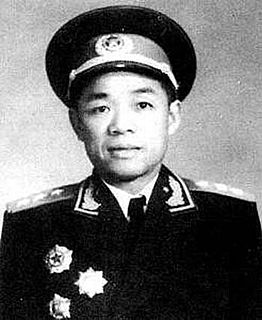
Fu Zuoyi was a Chinese military leader. He began his military career in the service of Yan Xishan, and he was widely praised for his defense of Suiyuan from the Japanese. During the final stages of the Chinese Civil War, Fu surrendered the large and strategic garrison around Beiping to Communist forces. He later served in the government of the People's Republic of China.

The Liaoshen Campaign, abbreviation of Liaoning–Shenyang Campaign, was the first of the three major campaigns launched by the Communist People's Liberation Army (PLA) against the Nationalist Kuomintang government during the late stage of the Chinese Civil War. This engagement is known in the Kuomintang as the Battle of Liaohsi. It took place between September and November 1948 and lasted a total of 52 days. The campaign ended after the Nationalist forces suffered sweeping defeats across Manchuria, losing major cities of Jinzhou, Changchun and eventually Shenyang in the process, eventually leading to the capture of Manchuria by the Communist forces.

Huaihai Campaign or Battle of Hsupeng was one of the military conflicts in the late stage of the Chinese Civil War between the Kuomintang and the Communist Party of China. The campaign started when the People's Liberation Army (PLA) launched a major offensive against the Kuomintang headquarter in Xuzhou on 6 November 1948, and ended on 10 January 1949 when the PLA reached the north of the Yangtze.

Operation Chahar, known in Chinese as the Nankou Campaign, occurred in August 1937, following the Battle of Beiping-Tianjin at the beginning of Second Sino-Japanese War.

Han Xianchu was a general of the Chinese Communist Party. Han participated in many military campaigns and battles such as Battle of Pingxingguan, Liaoshen Campaign, Pingjin Campaign, Hainan Campaign, and the Korean War. In 1955 he was among the first group of military leaders to be awarded the Shang Jiang rank.
Zhengtai Campaign was a series of battles fought between the nationalists and the communists during Chinese Civil War in the post World War II era, and resulted in the communist victory.
The Yanzhou Campaign, also known as the Campaign at the Central Section of the Tianjin-Pukou Railway was a series of battles fought between the nationalists and the communists for the control of the town Yanzhou (兖州), which is today under the administration of Jining, and the region to the north of the town in Shandong, China during the Chinese Civil War in the post World War II era, and resulted in communist victory.
Lanzhou Campaign was a series battle fought between the nationalists and the communists for the control of the largest city in northwestern China during the Chinese Civil War in the post World War II era, and resulted in the communist victory.
The Hebei – Rehe – Chahar Campaign (冀热察战役) was a series of battles fought in Northern China between the nationalists and the communists during the Chinese Civil War in the post World War II era, and resulted in communist victory.
Datong-Jining Campaign (大同集宁战役) was a series of battles fought between the nationalists and the communists mainly in northern Shanxi and the surrounding regions during the Chinese Civil War in the post-World War II era. The main battlefield was centered on two cities, Datong and Jining.
The Tianjin Campaign was the epitome of the Pingjin Campaign, and it was fought between the nationalists and the communists during the Chinese Civil War in the post-World War II era. The result of the Tianjin Campaign helped to determine the outcome of Pingjin Campaign.

The Battle of Shuangduiji (双堆集战役) was a major campaign fought between the nationalists and the communists during the Chinese Civil War in the post-World War II era, resulting in a communist victory. The campaign was part of the Huaihai Campaign.
The Bobai Campaign (博白战役) was a campaign fought between the nationalists and the communists during the Chinese Civil War in the post-World War II era and resulted in communist victory. The campaign was part of Guangxi Campaign.
Datong-Puzhou Campaign (同蒲战役) is a campaign communists fought against the nationalist during the Chinese Civil War in the post-World War II era in Shanxi, and resulted in communist victory.

The Landing Operation on Hainan Island, also known as the Hainan Island Campaign (海南岛战役) or the Hainan Campaign (海南战役) for short, was a series of battles fought between the Kuomintang (Nationalists) and the People's Liberation Army (PLA) for the island of Hainan during the resumption of the Chinese Civil War in the post-World War II period, and resulted in a Communist victory.

Liu Yalou was a general in the People's Liberation Army of the People's Republic of China, first commander-in-chief of the People's Liberation Army Air Force, as well as chief of staff of Lin Biao's army group during the Chinese Civil War, occupied the whole of Manchuria in 1948 and captured 472,000 Nationalist troops in the Liaoshen Campaign.
The Battle of Jinan was a critical engagement fought between the Kuomintang and the Communist Party of China (CPC) from September 16 to September 24, 1948 during the Chinese Civil War. The communist Eastern China Field Army besieged and finally captured the city of Jinan, the capital of Shandong Province and a major urban center as well as a transportation hub in northeastern China that had a population of about 600,000 at the time of the battle. The communist victory set the stage for the Huaihai Campaign.
The Guangxi Campaign was a campaign fought between the nationalists and the communists during the Chinese Civil War in the post-World War II era and resulted in communist victory.

The Yangtze River Crossing Campaign was a military campaign launched by the People's Liberation Army to cross the Yangtze River and capture Nanjing, the capital of the Nationalist government of the Kuomintang, in the final stage of the Chinese Civil War. The campaign began at night on 20 April, and lasted until 2 June 1949, concluding after the fall of Nanjing and Shanghai to the Communist forces.





















